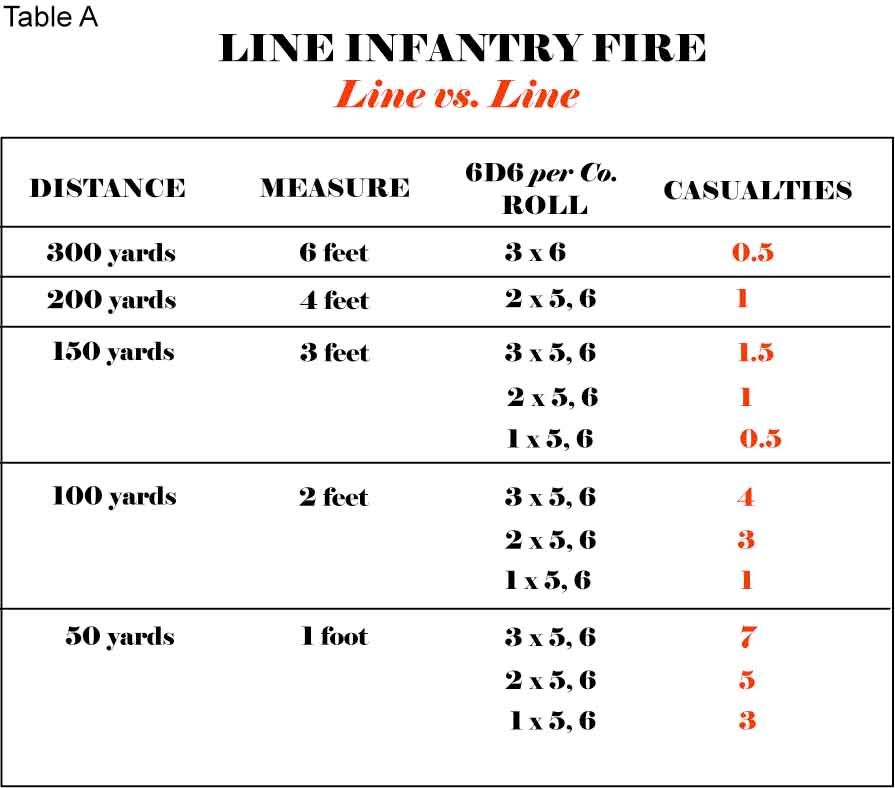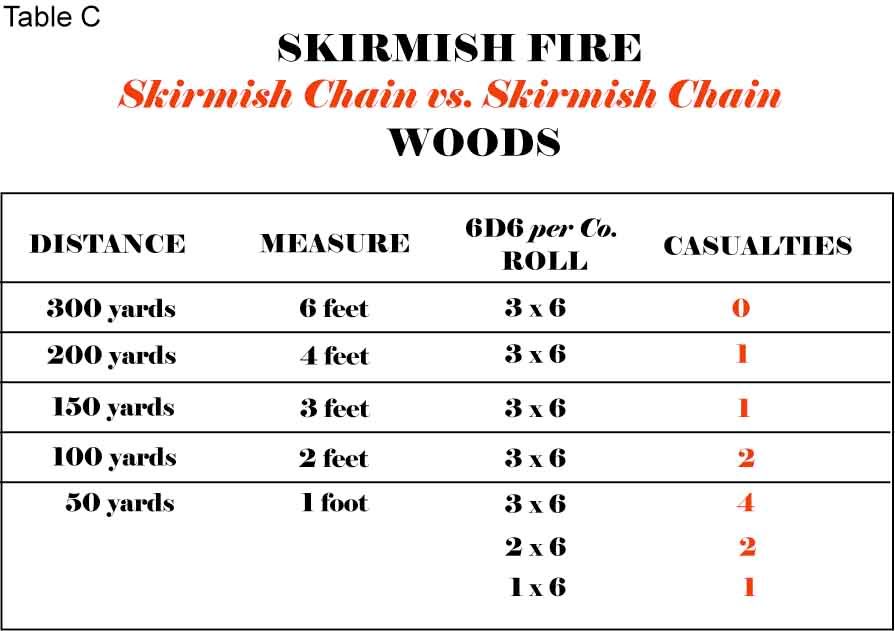Footsteps & Fire I

Musketry inflicted many casualties - probably over half those inflicted in most battles - but it was a poor way of resolving a combat. If neither side had the resolution to force a decision by attempting to charge, a protracted firefight was the most likely result. The effectiveness of each round would fall, but casualties would still accumulate. If both sides were good troops the result could be a bloody battle of attrition which destroyed the effectiveness of both units.
•Rory Muir, Tactics and the Experience of Battle in the Age of Napoleon, p84
When I read that I couldn't help but think of Lundy's Lane. All encounters and battles are unique in so many respects, but it is always interesting when an academic observation seems to accurately indentify a pattern that applies nicely.
I guess that is one of the major constraints on designing rules: not only must they be enjoyable to play, they must reflect what actually happened...or at least a realistic (and unpredictable) range of what could happen.
Before we begin to get some mechanisms up here for some basic infantry fire, and see if they might work, I'll pose a simple question I've been rolling around.
The US basic infantry pace was 24 inches.
The British basic infantry pace was 30 inches.
Having spent countless hours marching to perfect a 30 inch pace, enduring the pace stick measurements of senior NCOs at Fort Henry, and in turn learning the mysteries of pivoting that same device and gently tormenting others to get it right when my turn at it arrived, I have a pretty healthy respect for a 30 inch step. Adjusting longer and shorter paces for wheels and countermarches is something different, and is more the product of practice and peripheral vision to the appropriate rank marker. If you drill a certain pace, then it becomes the cornerstone of the rest of the drill.
So I have to admit I'm ruminating a bit over the 25% difference in paces between the Americans and British. I think it is statistically significant on the field, though at least one highly respected historian of the period told me it didn't matter.
The Americans and British both had a 75 pace a minute common step. Quick time for the US was listed in Smyth at 100 paces a minute; the British used 108. (Scott, in his 1815 manual mentioned yesterday, raised both the pace length to 28 inches and the common step to 90 paces a minute, with the quick step at 120 paces a minute.)
Double quick was about 120 or 140 paces a minute for both...though that is more an estimate than a firm range.
So, on our scale of 1 inch = 4 yards, the following figures for infantry over the course of a minute would be:
US common step 50 yards or 12 inches
British commom step 62 yards or 15 inches
US quick step 66 yards or 16 inches
British quick step 90 yards or 22 inches.
Let's give the US the same pace rate for a quick step (108) as their adversary, and that would make:
US quick step 72 yards or 18 inches.
Good distances on a small table. But let's take that as parade ground flat land, without the problems of a real rural field - uneven, gullied, muddy if not a clayey plowed abyss...which would require frequent redressing and other movements. (We'll factor in those on another day.) So for now at least we have a ballpark figure of how a reasonably drilled unit in both armies might progress in the best of all possible worlds.
Now feet were important only as a propulsion device for the musket. Or rather the vast array of muskets crammed together in tight formation.
The basic unit for these rules is the company, based on a 1 figure = 2 men ration. Companies of the period, on campaign, were fairly constant in the 50 man range, which gives us our 24 figure company, based in two 'platoons' of 12 figures. (Flank companies, and some US companies were closer to 75 men, and so these stronger units could have three 12 figure platoons.)
The primary firing unit for these rules will be the company, if operating as a detatched unit, or if of different rating than others it has been combined with (an example: a Militia flank company in line with almost raw Sedentary militia.)
If a regiment is in line with multiple companies, then one company still is the basic rolling unit, and the result is multiplied by the number of companies in the unit.
So, for firing, a company will roll six 6-sided dice (6d6), and 6s, or 5s and 6s in some ranges, will result in casualties.
In Table A we see how this is done, in close order line vs. close order line.

I've worked at this with some care, to try and allow a small chance of casualties (all mortal, serious, and incapacatating injuries together here) at the longest ranges. I've discounted most of the test data hits at these longest ranges, putting them down for rather ineffective (and so uncounted) minor wounds...though, if very lucky, a stray round might inflict damage...even at nearly 300 yards. Fat chance...but go for it; and if you have American troops in 1812 and 1813, or militia, then they probably will be trying for such a hit...maybe even out of your immediate control. (Another installment.)
It is a bit troubling, when you go through a book like Brent Nosworthy's Battle Tactics of Napoleon and His Enemies, and read estimates like 2/100 to 1/10,000 rates of musket balls fired to casualties. It seems he and Muir settle in at the 200 to 500 shots per casualty.
That's a lot of bookkeeping and dice-tumbling to approximate. So shaving down and down from different estimates and experiments, and playing with probability a bit, I think this could be an interesting attempt to get the 'nothing much usually happens, but rather quickly it can all get really horrible' result that seems to reflect both the modern research and contemporary accounts.
(I had said I do not want to inflict a lot of bookkeeping in these rules, and so apologize for the instances of .5 a casualty. It appeared the only way to make it seem to put a bit of realism into repeated long-range firing...without making it too rewarding and tempting a thing to do.)
From close-order line troops, let's see if we can adapt the basics for open order skirmishers.
A company of flank or light infantry or rifles (or Mohawk, Canadien etc.) would, rather than occupy two 1 inch by 2 inch stands, spread out over 4 of the same. Yet firing rolls would still be done per company. A company of Voltigeurs and one of Mohawk would roll separately, rather than multiply out one of the results.
So for skirmishers against another line of skirmishers, we have Table B:

In woods (or other heavy cover) the chart stays pretty much the same, with only the probability rising much higher. At this point, it is only a guess, instinctively trying to deduct the protection of open order, the trained use of cover, and laying that against the effectiveness of aimed fire.
It can give a pretty noisy but bloodless skirmish (as most seem to have logged in at), but again allows for the unexpected advantage to present itself.

Skirmisher companies firing against close-order line utilize the same chart as in Table A, but why not give them their own table - here labelled D.

Of course, these are all unmodified basic firing rates. The modifications will be kept to a minimum - hopefully only training level, length of firefight, and weather considerations will be needed to tweak these four basic musket charts...and that most of the key differences will have been factored in already in knowing the troop type and formation, and a rough distance.
But to those later.







2 Comments:
This is great I love your ideas
This is great I love your ideas
Post a Comment
<< Home